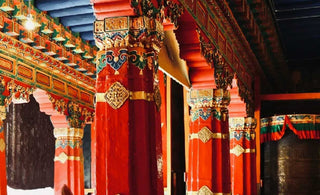
Introduction:
During the Qing Dynasty in China, Tibetan accessories held a distinct significance as symbols of wealth, status, and cultural identity. These opulent adornments, reflecting the grandeur of Tibetan artisanship, became integral to the Qing court's visual splendor. Through five key facets, this exploration delves into the intricacies, cultural contexts, materials, craftsmanship, and societal roles of these lavish Tibetan accessories during the Qing era.
The Qing Dynasty Green Tara Tibetan Antique Buddha Statue, adorned with intricate copper gilding, stands as a testament to the profound socioeconomic implications embedded in opulent accessories of this era. As we delve into the nuances of this exquisite artifact, we unravel the layers of meaning, cultural significance, and the role it played in the complex fabric of Qing Dynasty society.
The Green Tara, a revered figure in Tibetan Buddhism, embodies compassion and enlightenment. The choice of crafting a statue in copper, adorned with gilding, adds an extra layer of opulence. The use of such precious materials signifies not only religious reverence but also underlines the socioeconomic context of the time. Copper, a metal associated with durability and conductivity, reflects the enduring power dynamics within Qing society.
1.Cultural Significance:
The symbolism embedded in the Green Tara statue further enhances its socioeconomic resonance. Green Tara, known for her compassionate nature and swift responsiveness to the suffering of sentient beings, aligns with virtues highly valued in Qing society. By possessing a statue of Green Tara, individuals sought to align themselves with these virtues, further bolstering their image and societal standing.
Tibetan accessories within the Qing Dynasty were emblematic of a fusion of cultural exchange. They represented the amalgamation of Tibetan artistic traditions with the sophisticated aesthetic sensibilities of the Qing court. These adornments served not only as items of personal decoration but also as embodiments of Tibetan spirituality, beliefs, and societal hierarchies. Their design motifs often featured auspicious symbols and religious iconography, encapsulating the spiritual essence and cultural heritage of Tibet within the Qing Dynasty's regal milieu.
2.Materials and Craftsmanship:
The opulence of these Tibetan accessories lay in their meticulous craftsmanship and the employment of exquisite materials. Skilled artisans employed a range of materials, including gold, silver, precious gems, turquoise, coral, and intricately carved yak bones. Techniques like filigree, repoussé, cloisonné, and intricate enamel work were employed to create intricate patterns and designs, showcasing the unparalleled craftsmanship of both Tibetan and Qing artisans.
The copper gilding, with its radiant sheen, not only adds to the aesthetic appeal but also serves as a visual manifestation of wealth. During the Qing Dynasty, displaying opulence was a strategic move in the intricate dance of social hierarchy. The glittering surface of the statue was a reflection not only of the owner's material wealth but also of their access to resources and connections that allowed them to procure such luxurious artifacts.
Beyond personal adornment, the Green Tara Tibetan Antique Buddha Statue became a statement of affiliation within the hierarchical structure of Qing Dynasty society. Those who possessed such artifacts were not only signaling their economic prowess but also aligning themselves with the cultural and religious underpinnings of the time. These statues were not isolated symbols; they were part of a larger narrative that intertwined spiritual beliefs with societal expectations.
3.Socioeconomic Implications:
Ownership of these lavish accessories was emblematic of social status and power within Qing society. They were not merely decorative but also indicators of wealth and influence. Worn by aristocrats and members of the royal court, these accessories signaled one's proximity to the imperial circle and denoted the wearer's elevated social standing. Their significance extended beyond fashion, serving as markers of prestige and affiliation within the hierarchical structure of Qing Dynasty society.
4.Symbolism and Design:
The design language of Tibetan accessories during the Qing Dynasty was steeped in symbolism and cultural narratives. Elaborate motifs often depicted auspicious symbols such as the endless knot, lotus flowers, dragons, and phoenixes, each laden with profound meanings. These symbols were not only aesthetically pleasing but also held spiritual and cultural significance, representing prosperity, longevity, power, and enlightenment. The fusion of these symbolic elements with intricate designs rendered these accessories as embodiments of both beauty and profound cultural meanings.
5.Legacy and Contemporary Influence:
The legacy of these opulent Tibetan accessories transcends the Qing Dynasty era. Their influence resonates in contemporary fashion, art, and cultural expressions. Today, museums and collectors worldwide cherish these artifacts, acknowledging their historical, artistic, and cultural importance. Furthermore, their designs continue to inspire modern jewelry makers and fashion designers, who draw inspiration from the intricate craftsmanship and symbolic richness of these Qing-era Tibetan accessories.
Conclusion:
As we admire the intricacies of the Qing Dynasty Green Tara Tibetan Antique Buddha Statue, we are transported back to an era where material possessions were laden with social and cultural significance. In the dance of power and influence, these opulent artifacts played a crucial role in defining one's place within the complex tapestry of Qing society. The copper gilding, the embodiment of Green Tara's compassion, and the inherent socioeconomic symbolism together create a masterpiece that transcends time, offering us a glimpse into the interwoven threads of religion, wealth, and status in the Qing Dynasty.
"Regal Adornments: Opulent Tibetan Accessories of the Qing Dynasty" encapsulates the convergence of Tibetan cultural heritage and the grandeur of the Qing Dynasty. These accessories, with their exquisite craftsmanship, symbolic depth, and societal significance, serve as enduring testaments to a bygone era. They symbolize not only the aesthetic sophistication of the time but also the intricate interplay between cultures, cementing their place as treasured artifacts in the annals of history and continuing to inspire admiration and awe in the modern world.

Qing Dynasty Green Tara Tibetan Antique Buddha Statue Copper Gilding























